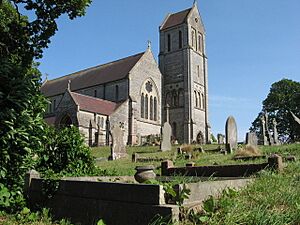St Augustine's Church, Penarth facts for kids
Quick facts for kids St Augustine's Church |
|
|---|---|
|
Eglwys Sant Awstin
|
|

The Church of St Augustine's
|
|
| 51°26′29″N 3°10′09″W / 51.4415°N 3.1691°W | |
| Location | Penarth, Vale of Glamorgan |
| Country | Wales, United Kingdom |
| Denomination | Church in Wales |
| History | |
| Founded | 13th century |
| Dedication | St Augustine of Hippo |
| Architecture | |
| Heritage designation | Grade I |
| Architectural type | Church |
| Style | Victorian |
St Augustine's Church (Welsh: Eglwys Sant Awstin) is a very old and important church in Penarth, Vale of Glamorgan, Wales. It was built in the 1800s in a style called Gothic Revival. This means it looks like the grand churches from the Middle Ages. The church is so special that it has a Grade I listing. This protects it as a historic building.
Contents
Discovering the Church's Past
People have known about a church on this spot since 1242. Back in 1183, a group called the Black Canons of St Augustine received this land. It was given to them by Osbert de Pennard. Later, William de Saltmarsh, who became an important bishop, told them to build the first church here.
The first church, built in 1242, was taken down in 1865. This was to make room for a newer, much bigger church.
A Landmark for Sailors
The church sits on a place called Pen Arth, which means "the Bear's Head." It is high up and can be seen from far away, even from Cardiff Bay. The first church had a tower that looked like a Norman castle. Sailors used this tower as a guide when they were sailing in the Bristol Channel.
When they planned the new church, they first wanted a short, square tower. But the sailors complained! They needed a tall tower to help them navigate. So, the plans were changed to include a 90-foot (about 27-meter) tower. During World War II, people worried about the tall tower. They thought it might help German planes find and bomb the docks in Cardiff.
Building the New Church
The church you see today was built because the old one was too small. More and more people were moving to Penarth. Harriet Windsor-Clive, 13th Baroness Windsor asked for the new church to be built.
A famous architect named William Butterfield designed the building. It was built between 1865 and 1866. The cost was about £10,000, which was a huge amount of money back then! The new church was built right where the old one stood. It is much bigger and can seat 1,000 people.
Inside the Church
Not much has changed inside the church since it was built. The new tower first held six bells. These bells were put in place soon after the church was finished. In 1935, these six bells were melted down and made into eight new bells.
The church also has a large organ. It was built in 1895 by a company called William Hill & Sons. There is an old medieval cross that used to be outside in the churchyard. Now, it is kept safe inside the church, near the Lady Chapel altar. This cross is a protected historical item.
The church became a Grade I listed building in 1989. This is because it is seen as one of the most important buildings designed by its architect in Wales. It is a perfect example of Victorian church design.
What the Church Looks Like
The church was designed in a simple version of the Gothic Revival style. It has a special roof on its tower called a saddleback roof. This roof looks like a saddle.
The walls are made of limestone from Leckwith. They have decorations made of bath stone and red tiles. The roof edges have special stone carvings and shapes. The tower has four levels and strong supports called buttresses. Inside, the church has colorful brick patterns and more stone decorations. The roof of the main part of the church is steep.
One expert, John Newman, said the church is "one of Butterfield's finest churches." He described it as strong and plain on the outside, but very colorful and detailed on the inside.
The Churchyard
The area around the church, called the churchyard, has many graves. In 2015, a group called the Friends of St Augustine's said the churchyard needed a lot of care. They suggested turning parts of it into a public park. Many old graves had fallen apart, making it hard to walk safely. Also, it cost a lot to keep the churchyard tidy.
The idea of turning churchyards into parks is not new. Other places have done it. The group wanted to create places for people to sit and for wildlife to live. They also wanted to make sure the oldest and most important graves were looked after. They received money to study if this plan would work for St Augustine's churchyard.
A famous Welsh composer named Joseph Parry is buried here. Until a new cemetery opened in Penarth in 1903, St Augustine's churchyard was the only place to be buried in the town.
War Graves
There are 14 special memorials in the churchyard. These are from the Commonwealth War Graves Commission. They mark the graves of soldiers from Britain and other Commonwealth countries. Ten of these soldiers fought in the First World War. Four soldiers fought in the Second World War. One of the graves is for a soldier from the Australian army.


